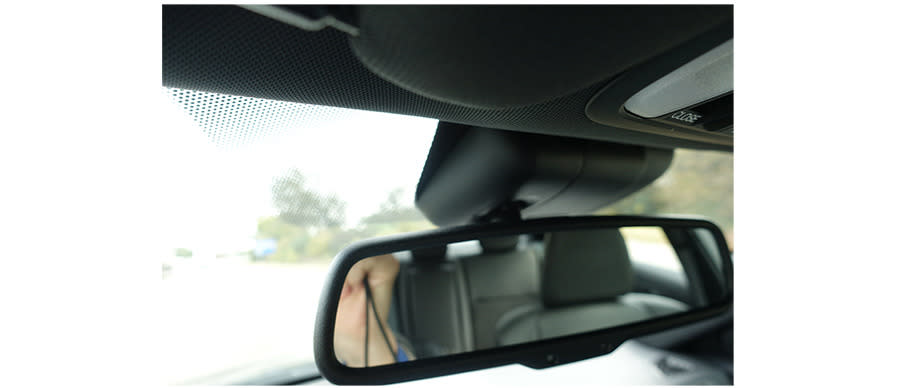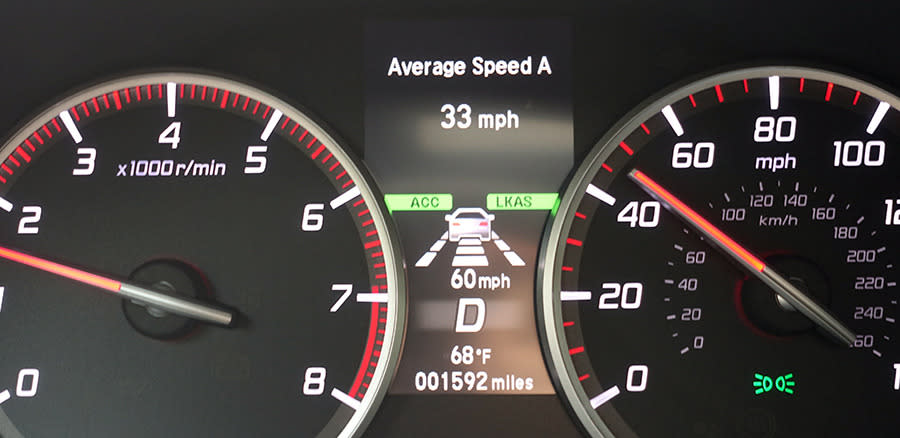Self-Driving Cars Are Here Today — and Here to Stay
We hear plenty about Google’s self-driving cars. They’re completely autonomous: Once you’ve plugged in your destination, you can, in theory, read or take a nap while the car drives. But Google’s cars are experimental. You can’t buy one.
What we hear less about are the self-driving cars that you can buy today. So far, they’re not fully autonomous, like Google’s. You’re required to keep at least one hand on the wheel while driving. In this regard, they’re strictly a stopgap between today’s cars and the fully self-driving models of 2020 or so.
The main things these cars can’t do on their own: making turns and changing lanes. (The one exception: With a $2,500 software upgrade, recent Tesla S models can now change lanes automatically when you turn on your turn signal on a highway).
But today’s cars can automatically steer (to stay in the lane), accelerate, brake, and park, either parallel or back-in.
Last week, Yahoo Autos invited me to join their judging panel for the Yahoo Autos Ride of the Year competition. Over the course of several days in Detroit, we tested, drove, and discussed 22 new 2016 car models.

The Volvo XC90 is one of the most autonomous autos on the road (Photo: Volvo).
Yahoo Autos will reveal the results in November. But I was so amazed by the degree of sophistication in these cars’ self-driving features, I thought I’d write up my reactions now.
The features here are available only on expensive cars, as an expensive option; they usually require an options package that costs around $2,000. They’ll inevitably trickle down to more affordable cars over time.
Adaptive Cruise Control
Cruise control has been around for years: You turn it on, and the car maintains a speed that you’ve set, so you don’t have to keep the gas pedal pressed all the time.
In retrospect, it’s amazing that this feature ever became standard. If you think about it, it’s dangerous. The car is accelerating blind. If you’re not careful, you’ll plow right into a car that’s slowed or stopped ahead of you.
But adaptive cruise control is very different. Now, your car watches the car ahead. It still tries to maintain your chosen highway speed (say, 65 miles an hour), but slows down as necessary to avoid hitting a car ahead of you—and then speeds back up again automatically.
The car’s ability to “see” ahead of it lies in a bulky box behind the rear-view mirror or built into the front grille, depending on whether it’s laser- or radar-based.

So how much of a gap does your car leave between you and the guy ahead of you? That’s up to you. A control on the steering wheel lets you cycle between three degrees of separation distance.

Adaptive cruise control is fantastic and very polished. I let a 2016 Honda CR-V drive itself almost all the way to the Detroit airport, and the thing never missed. Once, a car in front of me stopped short. The Honda braked hard and fast, yet without a sudden jerk. Collision avoided.
Auto-Stop-and-Go
On most cars, you can use adaptive cruise control only over, for example, 40 miles an hour. A few, though, offer something truly mind-blowing: a similar feature that works all the way down to zero miles an hour.
This feature has various names—on the Volvo XC90, for example, it’s called Pilot Assist; on the Mercedes S-class it’s called Stop-N-Go Pilot. But the idea is the same in each case: The car can drive itself when you’re inching along in stop-and-go traffic. It’s cruise control for traffic jams.
This is another prize-winning feature. Nothing can completely take the frustration out of traffic. But knowing that your car is handling the brake and accelerator, smoothly and efficiently, at least makes it feel like someone (or something) is on your side.
Lane Assist
With one press of a button on the steering wheel, these cars can do something else rather amazing: They can stay in the current lane. If you start to drift outside of the lines, they either alert you, steer automatically back into the lane, or both. (On the Audi TT and Ford Edge, the steering wheel vibrates in your hands to get your attention, for example.)

This feature isn’t as rock-solid as the adaptive cruise stuff. A couple of times, the Volvo drifted over the white line at the right side of the road without correcting itself. (This was a deserted rural Michigan road. The white line was clear enough to me, but the problem may have been that there wasn’t much pavement to the right of the white line.)
The Mercedes GLE350 4Matic had the opposite problem. It was smart enough to ease back into the lane when I drifted over the right white line—but not the yellow center line.
Most cars, moreover, don’t stay in the lane if the road curves more than a few degrees. (One exception: The Honda Pilot. It’s a master of staying in its lane, both sides, even if the road bends.)
An important lesson here: Lane correction doesn’t work well enough that you can relax. It might even lull you into a sense of confidence, but in fact, you need to pay just as much attention as you do when driving unassisted.
As the Mercedes manual puts it: “DISTRONIC PLUS can neither reduce the risk of accident nor override the laws of physics.”
Parking Assist
How’s this for a crazy breakthrough? You press a button on your dashboard—once for parallel parking, twice for head-in parking. Now, a message on the screen tells you to drive forward slowly; as you move, cameras on the side of the car look for a parking space.

When it finds a spot, the screen tells you to stop and put the car in reverse. As you inch backward, the steering wheel wildly turns by itself, as though manipulated by a ghost. Eventually, you’re instructed to stop and put the car into Drive again, then into Reverse again, and so on, until you’re neatly parked.
Oddly, all the car does for you is steer. You’re expected to do the braking, shifting, and accelerating. (I’m not complaining—just mystified, since the car is perfectly capable of monitoring obstacles and its own speed.)
There is a huge variation in the competence of this auto-parking business. Some cars I tested, like the Chevy Malibu and Camaro, usually did a pretty terrible job at parking. Often, I’d be midway through the procedure, having obeyed the instructions perfectly, and the car would simply give up with a “PARKING FAILED” message. OK, car—but weren’t you the one who decided that you could pull it off to begin with?
Those cars are looking, I’m guessing, for other parked cars, not for the painted lines of the parking spot. That would explain why, in one parking lot, it expertly guided itself squarely onto the dividing line between two spots.
I had better luck with some other car brands, but none was perfect.
Situational Awareness
External sensors are a hallmark of the new generation of cars. Not just the windshield laser array described above, but also external cameras that some cars have all the way around.
These cameras and sensors are essential elements in the self-driving features, of course. But they also make possible all kinds of useful new ways to keep you aware. For example:
* Overhead view. Using clever image-stitching software, the car can combine the images from all of the external cameras into what seems to be an aerial view of your car and its surroundings:

* Forward-collision alert. If the car determines that you might hit the car in front of you, you get a beep and flashing icon. (Some cars also tighten your seatbelt and pre-charge your brakes.)
* Blind-spot alert. If you’re about to change lanes, and there’s another car in your mirror’s blind spot, you get a beep and a flashing light in the mirror.
* Lane-drift alert. Even if a car doesn’t have the “keep you in your lane” feature, it may be able to beep, flash, or vibrate the steering wheel to warn you.
* Cross-traffic alert. This one kicks in when you’re backing up. The car can spot a car that might hit you, coming from the side; it beeps and flashes an alert to let you know.
You can turn all of these things off, but it’s hard to think of a reason. If you’re driving safely and all is well, you’ll never know these alarms are there. But when the time comes, those beeps and flashes may save your car—or your life.
Co-Driving
When fully self-driving cars finally arrive—within five years, most experts guess—you’ll be able to nap, read, eat, or watch videos while you drive.
You might expect that these halfway-there cars might mean that you can therefore pay attention to driving only half as much. Or at least a little bit less.
That’s not the case. The kind of attention you have to pay does shift—for example, you can relax a little about rear-ending the car in front of you. But in my days of helping these cars drive, I learned that these assistive features only morph your driving skills, not replace them.
The car makers know that, too. That’s why, even when the car is managing highway (or stop-and-go) driving and lane-keeping, you’re still required to keep at least one hand on the wheel. If you don’t, beeps and messages get angry at you.
What Self-Driving Means
I already know what a lot of people will say when they’re offered these features: “I like to drive! I don’t want some computer driving for me!”
Understood. They’re optional. You don’t have to buy them, and you don’t have to turn them on.
But the advantages of self-driving cars are enormous. Think about those tens of millions of aging baby boomers whose years of mobility can be extended. Think about the fuel consumption and traffic that can be avoided by smarter, safer cars.
Above all, think of the accidents and deaths that can be avoided. According to the latest statistics, 100 percent of car accidents are caused with people behind the wheel. We are, as a species, terrible drivers. We get bored and distracted. Worldwide, we crash 10 million times a year, and kill 1.3 million people.
The self-driving features that enhance our safety, like adaptive cruise control, blind-spot warnings, and cross-traffic alerts, are brilliant advances. They work. They avoid accidents. The Insurance Institute for Highway Safety found that an automatic front-collision braking feature alone cuts crashes by 15 percent.
True, we’re living in the Commodore 64 era of self-driving cars, where self-driving features are expensive, limited, and not always perfect. Years from now, we’ll chuckle at how quaint these transitional efforts were.
But all technology takes time to ripen. And even the semi-autonomous car models of 2016 will strike most people as pretty magical.
David Pogue is the founder of Yahoo Tech. To get his columns by email, read here. On the Web, he’s davidpogue.com. On Twitter, he’s @pogue. On email, he’s poguester@yahoo.com. He welcomes non-toxic comments in the Comments below.

